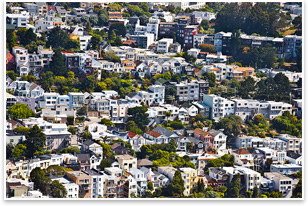
|
San Francisco Moves Toward Far-Reaching Green Building Code
Strong mayoral support “The resulting green building ordinance challenges the building industry to step up to the challenge of delivering well-designed and high performing projects that will slash greenhouse gas emissions and deliver healthier environments for occupants,” Newsom said. “I am confident that our talented pool of architects, engineers, and builders already doing great work on the environment will continue their tradition of innovation and help to deliver the next generation of truly sustainable 21st century buildings worthy of our great city and its people." LEED and GreenPoint ratings High-rise residential buildings will have to achieve LEED-certified status upon the effective date of the new law and transition to LEED Silver after 2010, while new commercial buildings over 25,000 square feet and new interiors and major renovations over 25,000 square feet will have to reach LEED Gold Certification by 2012. High-rise residential and large commercial buildings will have to achieve energy reductions 14 percent better than Title 24 upon enactment of the law. These building types will also have to meet specific LEED credits on areas ranging from water-efficient landscaping to enhanced building commissioning. Architects like it “Margie O’Driscoll and Bill Worthen were instrumental in helping to craft the language of the final bill. Our Board’s agenda is to advocate for the 2030 Challenge, and policies like this help move us closer to this goal,” Devlin said. “The [AIA San Francisco] board endorsed this legislation wholeheartedly, and we announced this in our testimony. AIA San Francisco has been and will continue to be a resource to the city on this and many other important issues.” “It is clear that at every level, the AIA is poised to play a significant part in this conversation,” remarked AIA Vice President Clark Manus, FAIA. He reinforced that AIA efforts in 2007 culminated in a major victory on the energy bill in Congress and has led us to using DesignVote 08 to garner continued attention on this issue.
|
||
Copyright 2008 The American Institute of Architects. All rights reserved. Home Page |
||
news headlines
practice
business
design
For more information about San Francisco’s new Green Building Code, read the AIA Angle, the e-newsletter from the Government and Community Relations Team.

